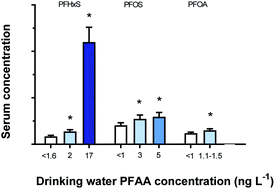Determinants of serum concentrations of perfluoroalkyl acids (PFAAs) in school children and the contribution of low-level PFAA-contaminated drinking water†
Abstract
Little is known about the demographic/life-style/physiological determinants explaining the variation of serum perfluoroalkyl acid (PFAA) concentrations in children. We identified significant determinants in children and investigated the influence of low-level PFAA-contaminated drinking water (DW) (<10 ng L−1 of single PFAAs) on serum concentrations. Four perfluorosulfonic acids (PFSAs) and 11 perfluorocarboxylic acids (PFCAs) were analyzed in serum from 5th grade children from 11 Swedish schools (N = 200; average age: 12 years) using liquid chromatography-tandem-mass-spectrometry. Data on demography and life-style/physiological factors were obtained by questionnaires. PFAA concentrations in raw and drinking water (DW) were obtained from the water works supplying DW to the schools. In multiple regression analyses school was the determinant contributing most to the variation in PFAA concentrations, with the lowest contribution for PFHpA (10%) and the highest for PFHxS (81%). Girls had lower adjusted mean concentrations of PFHxS, PFOS, PFNA and PFDA than boys, but a higher concentration of PFHxA. Girls reporting onset of menstruation had lower PFHxS and PFOA concentrations than other girls, suggesting menstrual bleeding elimination. Children born by mothers from less industrialized countries had lower mean concentrations of both PFSAs and PFCAs than children with mothers from highly industrialized countries, suggesting differences in early-life exposure. Life-style factors associated with paternal education levels appeared to influence PFAA concentrations differently than maternal education level. Already at an average DW PFHxS concentration of 2 ng L−1, children had a significantly higher adjusted mean serum PFHxS concentration than at an average DW concentration of <1.6 ng PFHxS L−1. Similar results were observed for PFOS and PFOA. The DW variable explained 16% (PFOA) to 78% (PFHxS) of the variation in serum PFAA concentrations, suggesting that low-level-contaminated DW is a significant source of exposure for children in Sweden. Although some of the associations, especially those with menstruation and maternal birth country, should be interpreted with extra caution due to the small size of the study, the results contribute to future work on identifying populations of children at risk of elevated PFAA exposures.



 Please wait while we load your content...
Please wait while we load your content...